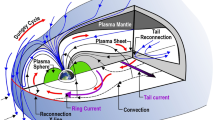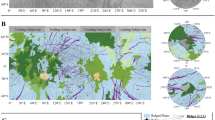Abstract
Repeated absolute gravity measurements in Fennoscandia have revealed that the on-going post-glacial rebound can be regarded as a pure viscous flow of mantle mass of density 3390 kg/m3 towards the central part of the region caused by a gravity/uplift rate of −0.167 μGal/mm. Our model estimates the rebound induced rates of changes of surface gravity and geoid height to have peaks of −1.9 μGal/yr and 1.6 mm/yr, respectively, the former being consistent with absolute gravity observations. The correlation coefficient of the spherical harmonic representations of the geoid height and uplift rate for the spectral windows between degrees 10 and 70 is estimated to −0.99±0.006, and the maximum remaining land uplift is estimated to the order of 80 m. Both the (almost) linear increase of relaxation time with degree and the linear relation between geoid height and uplift rate support a model with mass flow in the major part of the mantle and disqualify the model with a flow in a thin channel below the crust. The mean viscosity of the flow in the central uplift region is estimated to 4×1021 Pa s.








Similar content being viewed by others
References
Ågren J, Svensson R (2007) Postglacial land uplift model and system definition for the new Swedish height system RH 2000. Reports in Geodesy and Geographical Information Systems, LMV-Rapport 2007:4. Lantmateriet, Gävle, Sweden
Ågren J, Svensson R (2011) The height system RH 2000 and the land uplift model NKG2005LU. Mapp Image Sci 2011(3):4–12
Balling N (1979) The land uplift in Fennoscandia, gravity field anomalies and isostasy. In: Morner (ed) Earth rheology, isostasy and eustasy. Wiley, New York
Bergstrand S, Scherneck H-G, Milne GA, Johansson JM (2005) Upper mantle viscosity from continuous GPS baselines in Fennoscandia. J Geodyn 39:91–109. doi:10.1016/j.jog.2004.08.004
Bjerhammar A, Stocki S, Svensson L (1980) A geodetic determination of viscosity. The Royal Institute of Technology, Stockholm
Cathles LM (1971) The viscosity of the Earth’s mantle. PhD thesis, Princeton University
Cathles LM (1975) The viscosity of the Earth’s mantle. Princeton University Press, Princeton
De Geer G (1888) Om Skandinaviens nivåförändringar under Quartärperioden. Geol Fören Stockh Förh 10:366–379
De Geer G (1890) Om Skandinaviens nivåförändringar under Quartärperioden. Geol Fören Stockh Förh 12:61–110
Ekman M, Mäkinen J (1996) Recent postglacial rebound, gravity change and mantle flow in Fennoscandia. Geophys J Int 126(1):229–234. doi:10.1111/j.1365-246X.1996.tb05281.x
Ekman M, Mäkinen J, Midsundstad Å, Remmer O (1987) Gravity change and land uplift in Fennoscandia. Bull Geod 61:60–64
Fjeldskaar W, Cathles L (1991) The present rate of uplift of Fennoscandia implies a low-viscosity asthenosphere. Terra Nova 3:393–400
Gitlein O (2010) Absolutgravimetrische Bestimmung der Fennoscandischen Landhebung mit dem FG5-220. German Geodetic Commission, No 643, Series C (Dissertations)
Goiginger H, Rieser D, Mayer-Guerr T, Pail R, Schuh W-D, Jäggi A, Maier A (2011) GOCO, consortium: the combined satellite-only global gravity field model GOCO02S. European Geosciences Union General Assembly, Wien, 04.04.2011
Haskell NA (1935) The motion of a viscous fluid under a surface load. Physics 6:265–269
Kaufmann G, Lambeck K (2000) Mantle dynamics, postglacial rebound and the radial viscosity profile. Phys Earth Planet Inter 121:301–324
Lambeck K, Smither C, Ekman M (1998) Test of glacial rebound models for Fennoscandia based on instrumented sea- and lake-level records. Geophys J Int 135:375–387
Lidberg M, Johansson JM, Scherneck H-G, Milne GA (2010) Recent results based on continuous GPS observations of the GIA process in Fennoscandia from BIFROST. J Geodyn 50:8–18. doi:10.1016/j.jog.2009.11.010
Lliboutry LA (1971) Rheological properties of the asthenosphere from Fennoscandian data. J Geophys Res 76:1433–1446
McConnell RK (1965) Isostatic adjustment in a layered earth. J Geophys Res 70:5171
McConnell RK (1968) Viscosity of the mantle from relaxation time spectra of isostatic adjustment. J Geophys Res 73(22):7089–7105. doi:10.1029/JB073i022p07089
Milne GA, Davis JL, Mitrivica JX, Scherneck H-G, Johansson JM, Vermeer M, Koivula H (2001) Space geodetic constraints on glacial isostatic adjustement in Fennoscandia. Science 291:2381–2385
Moritz H (1980) Advanced physical geodesy. Wichmann, Karlsruhe
Niskanen E (1949) On the elastic resistance of the earth’s crust. Ann Acad Sci Fenn, AIII 21:1–23
Olsson P-A, Ågren J, Scherneck H-G (2012) Modelling of the GIA-induced surface gravity change over Fennoscanida. J Geodyn 61:12–22
Peltier WR (1974) The impulse response of a Maxwell Earth. Rev Geophys Space Phys 12:649–669
Sauramo M (1958) Die Geschichte der Ostsee. Ann Acad Sci Fenn, AIII 51:1–522
Sjöberg LE (1983) Land uplift and its implications on the geoid in Fennoscandia. Tectonophysics 97:97–101
Sjöberg LE (1989) The secular change of gravity and geoid in Fennoscandia. In: Gregersen S, Basham RW (eds) Earthquakes at North-Atlantic passive mragins: neotechtonics and postglacial rebound. NATO ASI series C: mathematical and physical sciences, vol 266. Kluwer Academic, Dordrecht
Sjöberg LE (1990) A refined adjustement model for the secular change of gravity on the Fennoscanidian 63° latitude gravity line. In: Vysckocil P, Reigber C, Cross PA (eds) Global and regional geodynamics. IAG symposia, vol 101. Springer, Berlin, pp 337–348
Sjöberg LE, Nord T, Fan H (1991) The Fennoscandian geoid bulge and its correlation with land uplift and Moho depth. In: Schultz BE, Anderson A, Froidevaux G, Park M (eds) Gravimetry and space techniques applied to geodynamics and ocean dynamics. AGU geophysical monograph series, vol 82, pp 133–142
Sjöberg LE, Nord T, Fan H (1994) Further studies on the Fennoscandian gravity field versus Moho depth and land uplift. Bull Geod 69:32–42
Steffen H, Wu P, Wang HS (2010) Determination of the Earth’s structure in Fennoscandia from GRACE and implications on the optimal post-processing of GRACE data. Geophys J Int 182(3):1295–1310. doi:10.1111/j.1365-246X.2010.04718.x
Steffen H, Wu P (2011) Glacial isostatic adjustment in Fennoscandia—a review of data and modeling. J Geodyn 52(3–4):169–204. doi:10.1016/j.jog.2011.03.002
Van Bemmelen RW, Berlage HP (1935) Versuch einer mathematischen Behandlung geotektonischer Bewegung unter besonderer Berucksichterung der Undationstheorie. Gerlands Beitr Geophys 43:19–55
Van der Wal W, Kurtenbach E, Kusche J, Vermeersen B (2011) Radial and tangential gravity rates from GRACE in areas of glacial isostatic adjustment. Geophys J Int 187(2):797–812. doi:10.1111/j.1365-246X.2011.05206.x
Wahr JM, Davis JL (2002) Geodetic constraints on glacial isostatic adjustment. In: Mitrovica JX, Vermeersen BLA (eds) Ice sheets, sea level and the dynamic earth. Geodynamics series, vol 29. AGU, Washington, pp 3–32. doi:10.1029/GD029p0003
Walcott RI (1980) Rheological models and observational data of glacio-isostatic rebound. In: Mörner N-A (ed) Earth rheology, isostasy and eustasy. Wiley, Chichester
Watts AB (2001) Isostasy and flexure of the lithosphere. Cambridge University Press, Cambridge
Zhao S, Lambeck K, Lidberg M (2012) Lithosphere thickness and mantle viscosity inverted from GPS-derived deformation rates in Fennoscandia. Geophys J Int 190:278–292.
Acknowledgements
Dr. Jonas Ågren from The National Land Survey of Sweden (Lantmäteriet) is acknowledged for discussions and for preparing the land uplift data over Fennoscandia, which was used in this work. Also, Dr. G. Papp is cordially acknowledged for providing us with several valuable remarks that we considered for the final version of the manuscript.
Author information
Authors and Affiliations
Corresponding author
Appendix
Appendix
Let us assume that the elastic deformation of the crust of thickness D and density ρ c is negligible in the vertical direction. Then the disturbing potential T total at sea-level caused by the glacial depression of the crust is composed of the sum of the potential contributions from the deformations of the upper and lower surfaces (T up and T low ) by their depression d:
Here G is the gravitational constant Δρ is the difference between the mantle minus crust density contrast, σ is the unit sphere, R is sea-level radius, D is crustal thickness, l is the distance between computational point and integration point. The first integral is the effect on the Earth’s potential due to the mass deficit between sea-level and the depressed crust. The second term is the effect due to the depressed bottom of the crust into the mantle. Expanding the inverse distance in an exterior type of Legendre series, one obtains for the two potential contributions:
and
Summing up, one obtains the total disturbing potential at sea-level:
Rights and permissions
About this article
Cite this article
Sjöberg, L.E., Bagherbandi, M. A study on the Fennoscandian post-glacial rebound as observed by present-day uplift rates and gravity field model GOCO02S. Acta Geod Geophys 48, 317–331 (2013). https://doi.org/10.1007/s40328-013-0025-5
Received:
Accepted:
Published:
Issue Date:
DOI: https://doi.org/10.1007/s40328-013-0025-5




